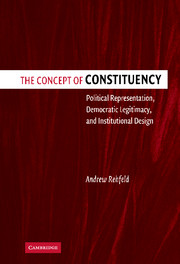 The Concept of Constituency
The Concept of Constituency Book contents
- Frontmatter
- Contents
- List of Tables
- Preface
- PART I CONCEPTUAL FOUNDATIONS: ON CONSTITUENCY AND POLITICAL REPRESENTATION
- PART II HISTORICAL JUSTIFICATIONS: ON THE ORIGINS OF TERRITORIAL CONSTITUENCIES IN THE UNITED STATES
- 3 Justifications and the Use of History
- 4 The English and Colonial Origins of Territorial Constituencies in the United States
- 5 Origins, Part 1: What Territorial Representation Was Not Meant To Do
- 6 Origins, Part 2: Territorial Representation as an Enabler of Democratic Values
- PART III NORMATIVE APPLICATIONS: ON LEGITIMATE REPRESENTATION AND INSTITUTIONAL DESIGN
- Index
4 - The English and Colonial Origins of Territorial Constituencies in the United States
Published online by Cambridge University Press: 27 July 2009
- Frontmatter
- Contents
- List of Tables
- Preface
- PART I CONCEPTUAL FOUNDATIONS: ON CONSTITUENCY AND POLITICAL REPRESENTATION
- PART II HISTORICAL JUSTIFICATIONS: ON THE ORIGINS OF TERRITORIAL CONSTITUENCIES IN THE UNITED STATES
- 3 Justifications and the Use of History
- 4 The English and Colonial Origins of Territorial Constituencies in the United States
- 5 Origins, Part 1: What Territorial Representation Was Not Meant To Do
- 6 Origins, Part 2: Territorial Representation as an Enabler of Democratic Values
- PART III NORMATIVE APPLICATIONS: ON LEGITIMATE REPRESENTATION AND INSTITUTIONAL DESIGN
- Index
Summary
The intimate and familiar propinquity group is not a social unity within an inclusive whole. It is, for almost all purposes, society itself.
–John DeweyWhy were modern representational institutions in England and America organized around territorial constituencies? A good first guess begins with Dewey's description of early human history, and emphasizes the decidedly local social and political structure of early modern England and the American colonies. Before the modern institutions of representative government were formed, the basis of life was decidedly local, small, and static. Geographic and social mobility were not the norm – indeed there were significant impediments to each – and as such it was difficult to attach strong sentiments to things not locally based. Even as late as the seventeenth century, communities sent delegates to English parliament because it was by local communities that individuals primarily organized their lives. Territorial representation was originally used to represent territorially distinct communities.
The nature of territorial representation quietly changed when district lines no longer matched existing communities – when small jurisdictional lines ceased to define a distinct constituency for national representation. This happened in England and the American colonies when the population grew (or was depleted by migration) and geographical mobility increased. As this happened during the seventeenth century in England (and during the eighteenth century across the Atlantic), the justification for territorial representation changed.
- Type
- Chapter
- Information
- The Concept of ConstituencyPolitical Representation, Democratic Legitimacy, and Institutional Design, pp. 69 - 80Publisher: Cambridge University PressPrint publication year: 2005
